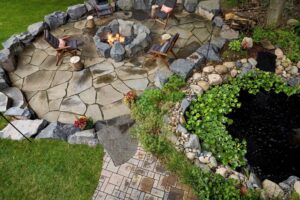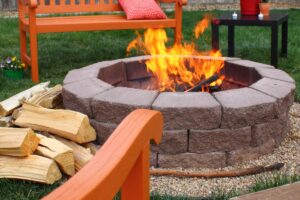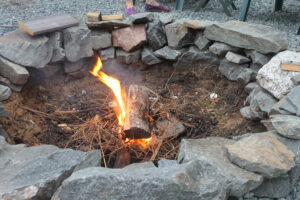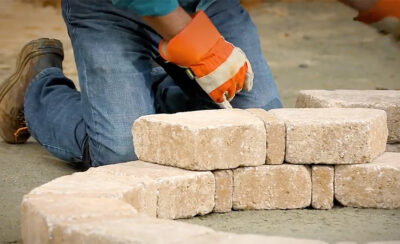Do you want to enhance the atmosphere of your backyard with a cozy fire pit, and do you want to learn how to build a fire pit with pavers? You are just in the right place. A fire pit is not only easy to do with a little planning and basic tools, but it’s also a great way to transform your outdoor space into a warm and inviting place to relax and entertain.
Building a fire pit with pavers is a relatively simple DIY project that can add a beautiful and functional element to your backyard. It involves choosing a flat, well-draining location, marking the outline of the fire pit, excavating the area, adding a layer of gravel, laying the pavers, filling in gaps with sand, and adding a fire ring or grate.
With a little bit of planning and effort, you can create a stunning fire pit that you and your loved ones can enjoy for years to come. Just be sure to follow all local fire regulations and use caution when building and maintaining a fire in your pit.
How to build a fire pit with pavers

Building a fire pit with pavers is a great DIY project that can add a beautiful and functional element to your backyard. Here’s a step-by-step guide on how to do it:
1. Choose a flat, well-draining area for your fire pit. Avoid building it too close to trees, buildings, or other structures.
2. Mark the outline of your fire pit using spray paint or wooden stakes and string. The size of your fire pit will depend on the size of your pavers and the desired size of your finished pit.
3. Excavate the area within the marked outline to a depth of about 6 inches. Use a shovel or mini excavator to remove grass, soil, and any other debris from the area.
4. Add a layer of gravel to the bottom of the excavated area. This will help with drainage and prevent the pavers from sinking into the ground.
5. Begin laying your pavers around the outside edge of the fire pit, working inward. If you’re using circular pavers, you’ll want to start at the center and work outward. Use a rubber mallet to gently tap each paver into place, making sure they are level and evenly spaced.
6. Once you’ve laid all of your pavers, fill in any gaps between them with sand. Use a broom to sweep the sand into the gaps and tamp it down with a tamper or the back of the broom.
7. To finish the fire pit, you’ll need to add some form of a fire ring or grate to contain the fire. You can purchase a metal fire ring or grate, or you can make your own using metal rods or rebar. Simply place the fire ring or grate on top of the pavers, making sure it is level and centered within the pit.
That’s it and then you have a beautiful and functional fire pit that you can enjoy with friends and family on cool evenings. Just be sure to follow all local fire regulations and use caution when building and maintaining a fire in your pit.
Can you make a fire pit out of pavers?
Yes, it is possible to make a fire pit out of pavers. Pavers are a type of flat, pre-shaped stone or concrete block that can be used to create a variety of outdoor structures, including fire pits.
To make a fire pit out of pavers, you will need to choose a flat, well-draining area in your backyard, mark the outline of the fire pit, excavate the area to a depth of about 6 inches, add a layer of gravel, lay the pavers in a circular or square pattern (depending on the shape of your pavers), fill in any gaps between the pavers with sand, and add a fire ring or grate to contain the fire.
Building a fire pit with pavers is a simple DIY project that can add a beautiful and functional element to your outdoor space. Just be sure to follow all local fire regulations and use caution when building and maintaining a fire in your pit.
What pavers are best for a fire pit?
There are a few factors to consider when choosing pavers for a fire pit:
1. Heat resistance:
It’s important to choose pavers that can withstand high temperatures without cracking or breaking. Natural stone pavers, such as granite or basalt, are generally more heat-resistant than concrete pavers.
2. Durability:
Pavers that are made from durable materials, such as granite or concrete, will be less likely to crack or break under the weight of the fire pit or the heat of the fire.
3. Size:
The size of your pavers will depend on the size of your fire pit and the desired look of your finished project. Larger pavers will cover more area and may be easier to work with, but they may also be more expensive.
4. Shape:
Choose pavers that are either circular or square, depending on the shape of your fire pit. If you’re building a circular fire pit, circular pavers will work best. If you’re building a square or rectangular fire pit, square pavers will work best.
5. Color:
Choose pavers in a color that complements your outdoor space and personal style. Natural stone pavers come in a range of colors, while concrete pavers can be dyed to match your desired color scheme.
Ultimately, the best pavers for a fire pit will depend on your personal preferences and the specific needs of your project. Be sure to consider the factors above and choose pavers that will be durable, heat-resistant, and visually appealing in your outdoor space.
Choosing the right pavers for a fire pit project
There are a few key considerations to keep in mind when choosing pavers for a fire pit project:
Heat resistance:
It’s important to choose pavers that can withstand high temperatures and won’t crack or break when exposed to heat. Natural stone, such as granite or basalt, is a good choice for this reason.
Durability:
The pavers you choose should be able to withstand the weight of the fire pit and any furniture you put around it. Concrete pavers are a good choice for this reason, as they are strong and durable.
Size and shape:
Consider the size and shape of the pavers in relation to the size and shape of your fire pit. Larger pavers may be more difficult to install, but they can provide a more cohesive and cohesive look.
Color:
Choose a color that complements the surrounding landscape and your home’s exterior.
Slip resistance:
If your fire pit will be located in an area where it may get wet, it’s important to choose pavers that have a slip-resistant surface to prevent accidents.
It’s also a good idea to consider the overall style and design of your outdoor space when selecting pavers. This will help ensure that the fire pit fits in with the rest of your outdoor design.
Tools and materials needed to build a paver fire pit

To build a paver fire pit, you will need the following tools and materials:
- Pavers: As mentioned above, it’s important to choose pavers that are heat-resistant, durable, and slip-resistant.
- Sand: You will need a layer of sand to create a level base for the pavers.
- Gravel: You will need a layer of gravel to help drain water away from the fire pit.
- Landscape fabric: This will help prevent weeds from growing up through the pavers.
- A shovel: You will need a shovel to dig out the area for the fire pit and to level the base.
- A tamper: This will help you compact the base and ensure that it is level.
- A mason’s line and stakes: These will help you create a circular shape for the fire pit and ensure that it is level.
- A circular saw: You may need to cut some of the pavers to fit them around the circumference of the fire pit.
- A hammer and chisel: You may need to use these to split pavers if you are using natural stone.
- A level: This will help you ensure that the pavers are level as you lay them.
- Jointing sand: This will help fill in the gaps between the pavers and keep them in place.
- A broom: You will need a broom to sweep the jointing sand into the gaps between the pavers.
It’s also a good idea to have safety gear such as gloves, safety glasses, and a dust mask on hand when working with pavers.
The importance of proper drainage in a paver fire pit
Proper drainage is important in a paver fire pit for a few reasons:
1. To prevent water from pooling
If water is allowed to collect in the fire pit, it can cause the pavers to shift or sink, leading to instability and potential safety hazards. Proper drainage helps to prevent water from accumulating in the pit.
2. To prevent damage to the pavers
Water can cause damage to the pavers over time, leading to cracks, chips, and other issues. Proper drainage helps to prevent this damage by allowing water to flow away from the pavers and preventing it from sitting on the surface for extended periods of time.
3. To prevent erosion
If water is allowed to flow freely through the fire pit, it can cause erosion, leading to further instability and potential safety hazards. Proper drainage helps to prevent erosion by directing water away from the pit and preventing it from flowing through the area.
There are a few steps you can take to ensure proper drainage in your paver fire pit:
Install a drainage system: A drainage system can be installed beneath the pavers to allow water to flow away from the pit. This can include a layer of gravel, a drainage pipe, or other materials.
Slope the pit: Make sure the pit is sloped in a way that allows water to flow away from it. This can be achieved by using a laser level or other tools to ensure the pit is properly graded.
Use pavers with drainage holes: Some pavers are designed with holes or channels to allow water to flow through them. Using these types of pavers can help to improve drainage in the fire pit.
Keep the pit clean: Regularly cleaning the pit and removing any debris or accumulation of water can help to improve drainage and prevent potential issues.
Safety considerations when building and using a paver fire pit
There are several safety considerations to keep in mind when building and using a paver fire pit:
1. Follow local regulations: Check with your local authorities to ensure that it is legal to build a fire pit in your area, and follow any applicable regulations or codes.
2. Choose a safe location: Select a location for the fire pit that is a safe distance from buildings, trees, and other structures, and make sure it is not near any overhead power lines.
3. Use proper materials: Use fire-resistant materials, such as pavers or bricks, to build the pit. Avoid using wood, which can catch fire and pose a hazard.
4. Keep a water source nearby: Always have a water source nearby when using the fire pit, such as a garden hose or a bucket of water, in case of an emergency.
5. Supervise children: Keep children away from the fire pit and closely supervise them when they are in the area.
6. Follow proper fire safety procedures: Always use a spark screen to contain sparks and embers, and never leave a fire unattended. Make sure the fire is completely extinguished before leaving the area or going to bed.
7. Avoid using flammable liquids: Never use flammable liquids, such as gasoline or lighter fluid, to start or fuel a fire in the pit.
8. Use caution when handling hot coals: Use caution when handling hot coals or ashes, and dispose of them properly in a metal container with a lid.
By following these safety guidelines, you can enjoy your paver fire pit safely and responsibly.
How to light a fire in a paver fire pit

To light a fire in a paver fire pit, you will need to follow these steps:
1. Gather your materials: You will need a fire starter (such as newspaper, dryer lint, or a fire starter log), small twigs and sticks, and larger logs.
2. Prepare the fire pit: Make sure the fire pit is clean and clear of any debris. If you have a spark screen or fire grate, place it on top of the fire pit.
3. Build your fire: Start by crumpling up several sheets of newspaper or dryer lint and placing them in the center of the fire pit. Arrange the small twigs and sticks on top of the newspaper in a teepee shape.
4. Light the fire: Use a long match or lighter to ignite the newspaper. As the fire starts to catch, slowly add more twigs and sticks, gradually building up to larger logs as the fire grows.
5. Maintain the fire: Once the fire is lit, you will need to tend to it and add more logs as needed to keep it going. Make sure to keep the fire a safe distance from any flammable materials and never leave it unattended.
Remember to follow all local laws and regulations when lighting a fire in a paver fire pit.
Alternatives to using pavers for building a fire pit
There are several alternatives to using pavers for building a fire pit, including:
Brick: You can use brick to build a fire pit by stacking them in a circular shape and filling in the gaps with mortar.
Stone: Natural stone can be used to create a rustic and natural-looking fire pit. You can use flat stones to create a more modern look or rounded stones for a more traditional look.
Concrete blocks: Concrete blocks are another option for building a fire pit. They are easy to work with and can be stacked to create a variety of different shapes and sizes.
Metal fire ring: A metal fire ring is a pre-made, portable option for building a fire pit. These are typically made of metal and come in a variety of sizes and styles.
Wood: You can also build a fire pit out of wood, using logs or lumber to create the structure. This can give a more rustic and natural look but will require more maintenance to keep the wood in good condition.
Remember to follow all local laws and regulations when building a fire pit, and choose a material that is appropriate for your climate and location.
Conclusion
Whether you are looking to create a cozy gathering spot for your family and friends or simply want to enjoy the ambiance of a flickering fire, a paver fire pit can provide the perfect solution. However, you need to learn the right way on how to build a fire pit with pavers.
The process of building a fire pit with pavers is fairly straightforward and can be accomplished with just a few basic tools and materials. By following the steps outlined in this article, you can easily create a beautiful and durable fire pit that will provide countless hours of enjoyment for you and your loved ones.
Whether you opt for a more traditional circular design or a more modern, rectangular shape, a paver fire pit can be a versatile and stylish addition to any outdoor space. So why wait? Gather your materials, choose a location, and get started on building the fire pit of your dreams today.

